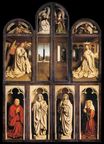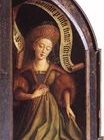Jan van Eyck - The Cumaean Sibyl 1432
 |
 |
 |
 |
 |
 |
 |

The Cumaean Sibyl 1432
oil on wood
St. Bavo Cathedral, Ghent, Belgium
<< Previous G a l l e r y Next >>
From Wikipedia, the free encyclopedia:
The Ghent Altarpiece (or the Adoration of the Mystic Lamb, Dutch: Het Lam Gods) is a very large and complex 15th-century polyptych altarpiece in St Bavo's Cathedral, Ghent, Belgium. It was begun c. the mid-1420s and completed before 1432, and is attributed to the Early Netherlandish painters and brothers Hubert and Jan van Eyck. The altarpiece is considered a masterpiece of European art and one of the world's treasures.
The figures in the lunettes refer to prophecies of the coming of Christ. The far left lunette shows the prophet Zechariah and the far right one shows Micah. The two much taller inner shutters show the Erythraean Sibyl (on the left) and the Cumaean Sibyl on the right. Each panel includes a text inscribed on a floating ribbon or "banderole", while the identities of the figures are carved on the lower border of each panel. Zechariah's text, taken from Zechariah 9:9, reads EXAULT SATIS FILIA SYON JUBILA ECCE REX TUUS VENTI ("Rejoice greatly, O daughter of Zion ... behold, your king comes"), while the Erythraean Sibyl's words are NIL MORTALE SONAS AFFLATA ES NUMINE CELSO ("Sounding nothing mortal you are inspired by power from on high").[60] To the right the Cumaean Sibyl's reads REX ALTISSIMUS ADVENIET PER SECULA FUTURUS SCILICET IN CARNE ("The Highest King shall come and shall be in the flesh through the ages").